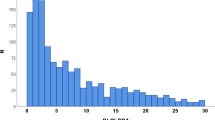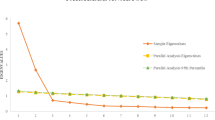Abstract
Purpose
The aim in the present study was to establish underlying dimensions of quality of life in Sweden, measured by QLI, and to obtain reference values among a representative sample between 18 and 80 years of age from the general Swedish population.
Method
A total of 1,680 randomly selected persons completed the questionnaire (57% response rate). All data were coded and entered into the statistical software. Factor analysis, maximum-likelihood method with oblique rotation, was employed to explore and reveal underlying dimensions of the QLI. To describe QLI total and subscale reference values for different age groups and men and women, respectively, means and 95% CI as well as medians and quartiles were used. For comparisons related to demographic and background variables, parametric and non-parametric analyses were used (α = 0.01). All data were analysed using SPSS 14.0 statistical software.
Results
Four underlying dimensions emerged: Family and friends, Health and functioning, Social and economic and Psychological/spiritual. Mean values for the total QLI and the four subscales ranged between 17.2 and 23.7 (possible range = 0.0–30.0).
Conclusions
The overall QLI and subscale scores correspond with those presented by other researchers. Population-based measures of generic quality of life and underlying dimensions are important considering the gain when results from specific patient groups are viewed.
Similar content being viewed by others
Abbreviations
- QLI:
-
Quality of Life Index
- WHOQOL:
-
World Health Organisation Quality Of Life
- CI:
-
Confidence interval
- IQR:
-
Interquartile range
References
Tatarkiewicz, W. (1976). Analysis of happiness. Nijhoff: The Hague.
Allardt, E. (1976). Dimensions of welfare in a Comparative Scandinavian Study. Acta Sociologica, 19(3), 227–239.
Nordenfelt, L. (1994). Towards a theory of happiness: A subjectivist notion of quality of life. In L. Nordenfelt (Ed.), Concepts and measurement of quality of life in health care (pp. 35–57). Dordrecht: Kluwer.
Naess, S. (1987). Quality of life research: Concepts, methods and applications. Oslo: Institute of Applied Social Science.
Brülde, B. (2007). Happiness theories of the good life. Journal of Happiness Studies, 8(1), 15–49.
The WHOQOL Group. (1995). The World Health Organization quality of life assessment (WHOQOL): Position paper from the World Health Organization. Social Science and Medicine, 41(10), 1403–1409.
Ferrans, C. E., Powers, M. J. (1992). Psychometric assessment of the Quality of Life Index. Research in Nursing & Health, 15(1), 29–38.
Ferrans, C. E. (2008). Ferrans and Powers Quality of Life Index (QLI). http://www.uic.edu/orgs/qli/index.htm. Accessed April 8, 2008.
Veenhoven, R. (2000). The four qualities of life. Journal of Happiness Studies, 1(1), 1–39.
Ferrans, C. E. (1990). Quality of life: Conceptual issues. Seminars in Oncology Nursing, 6(4), 248–254.
Ware, J. E., & Sherbourne, C. D. (1992). The MOS 36-item short-form health survey (SF-36). Medical Care, 30, 473–483.
Sullivan, M., Karlsson, J., & Ware, J. (1995). The Swedish SF-36 Health Survey-I. Evaluation of data quality, scaling assumptions, reliability and construct validity across general populations in Sweden. Social Science and Medicine, 41, 1349–1358.
Persson, L.-O., Karlsson, J., Bengtsson, C., Steen, B., & Sullivan, M. (1998). The Swedish SF-36 Health Survey II. Evaluation of clinical validity: Results from population studies of elderly and women in Gothenburg. Journal of Clinical Epidemiology, 51, 1095–1103.
Sullivan, M., & Karlsson, J. (1998). The Swedish SF-36 Health Survey III. Evaluation of criterion-based validity: Results from normative population. Journal of Clinical Epidemiology, 51, 1005–1113.
Ferrans, C. E., & Powers, M. J. (1985). Quality of life index: Development and psychometric properties. Advances in Nursing Science, 8(1), 15–24.
Gustafsson, G. B., & Hamrin, E. K. (1996). Assessing disabled elderly with the Swedish version of the Quality of Life Index. In G. B. Gustafsson (Ed.), Quality of life and functional capacity among elderly with locomotor disability (pp. 74–87). Linköping, Sweden: Department of Caring Sciences, Linköping University. Linköping Studies in Health Sciences, Thesis no. 23.
Child, D. (2006). The essentials of factor analysis, 3rd rev. ed. London: Continuum.
Altman, D. G. (1991). Practical statistics for medical research. London: Chapman & Hall/CRC.
Haybron, D. (2007). Life satisfaction, ethical reflection, and the science of happiness. Journal of Happiness Studies, 8(1), 99–138.
Hagell, P., & Westergren, A. (2006). The significance of importance: An evaluation of Ferrans and powers’ quality of life index. Quality of Life Research, 15(5), 867–876.
Rustøen, T., Wiklund, I., Hanestad, B. R., & Burckhardt, C. S. (1999). Validity and reliability of the Norwegian version of the Ferrans and powers quality of life index. Scandinavian Journal of Caring Sciences, 13(2), 96–101.
Author information
Authors and Affiliations
Corresponding author
Rights and permissions
About this article
Cite this article
Gullberg, M.T., Hollman-Frisman, G. & Ek, AC. Reference values for the Quality of Life Index in the general Swedish population 18–80 years of age. Qual Life Res 19, 751–760 (2010). https://doi.org/10.1007/s11136-010-9627-3
Accepted:
Published:
Issue Date:
DOI: https://doi.org/10.1007/s11136-010-9627-3




